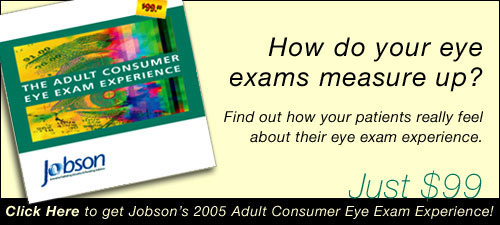
| |
Volume 5, Number 25
|
Monday, June 27, 2005
|

|
||

|
||
| Age-Related Eye
Disease, Quality of Life, and Functional Activity Decreased visual function, regardless of the pathologic reason for the decrease, is associated with diminished quality of life and functional activities of living, according to a study by the University of Wisconsin Medical School. A total of 2,670 people participated in the examinations of the Beaver Dam Eye Study and the Epidemiology of Hearing Loss Study, conducted from 1998 through 2000. Investigators assessed age-related eye disease (including age-related maculopathy, cataract, diabetic retinopathy, glaucoma, macula edema, occlusions, amblyopia and macular holes) by fundus, slit lamp and retroilluminated photographs, as well as self-reported ocular history. They also administered a standard interview that included the Medical Outcomes Study Short Form Health Survey, activities of daily living, instrumental activities of daily living, and visual function questionnaires and information on other medical conditions. After controlling for age and sex, researchers found that people with an age-related eye disease had decreased scores in almost all the domains of the Medical Outcomes Study Short Form Health Survey, and that people with eye disease in both eyes had poorer scores than those with eye disease in only one eye. Stratifying by age-related maculopathy and central cataract yielded similar results. Further adjustment for current visual acuity and the number of comorbid conditions explained most associations. Several of the mental scales were still marginally significantly lower in those with age-related maculopathy after adjustment. Those who had an age-related eye disease were not more likely to have impaired activities of daily living or instrumental activities of daily living. After adjustment for current visual acuity and number of comorbidities, people who had trouble reading small print or recognizing people across the street were more likely to have an age-related eye disease. Otherwise, the investigators found no significant associations with the visual function questions and any of the specific ocular conditions. |
|
SOURCE: Knudtson MD, Klein BEK, Klein R, et al. Age-related eye disease, quality of life, and functional activity. Arch Ophthalmol 2005; 123(6):807-14. |
|
| Coronary Artery
Disease and Risk Factors in People with Post-Traumatic Vision Loss
Investigators at Israel’s Tel-Aviv University examined the prevalence of coronary artery disease (CAD) and its risk factors in people with post-traumatic vision loss (PTVL) in a cross-sectional, controlled study. Study groups included 82 subjects with PTVL, 49 siblings, 58 blind subjects with retinitis pigmentosa (RP) and the general population in Israel. Main outcome measures were sociodemographic and biomedical data collected via a structured questionnaire and medical records. The prevalence of CAD among subjects with PTVL (24 percent) was 2 to 3 times higher than the control groups. However, the prevalence of the CAD risk factors in these subjects was similar to or lower than those in the control groups. For example, significantly fewer subjects with PTVL were physically inactive (16 percent) than patients with RP (55 percent). The only variable that was significantly associated with CAD prevalence was the cause of blindness--that is, trauma vs. disease. The odds of having CAD after traumatic vision loss was 3.75 times higher than after RP. The authors concluded that people with PTVL exhibit elevated rates of risk for CAD similar to those of other groups with physical disability, and that the traumatic injury that caused vision loss might be an important factor underlying that risk. |
|
SOURCE: Defrin R, Holtzman S, Katz M, et al. Coronary artery disease and risk factors in people with posttraumatic vision loss. Arch Phys Med Rehabil 2005;86(5):968-73. |
|
| Blunt Trauma
of the Aging Eye: Injury Mechanisms and Increasing Lens Stiffness
The Virginia Tech-Wake Forest Center for Injury Biomechanics, Winston-Salem, NC, investigated possible injury mechanisms in the eyes of elderly individuals and the effects of lens stiffness on model outputs indicative of injury as a function of age. Using a validated finite-element model to determine the effects of changing lens stiffness on the eye when subjected to blunt trauma, researchers simulated three separate frontal impact scenarios: a foam particle (30 miles per second), a steering wheel (15 miles per second) and an air bag (67 miles per second). The lens stiffness of the model was increased with increasing age using stiffness values determined from the literature for three age groups. The computational eye model demonstrated increasing peak stress in the posterior portion of the ciliary body and decreasing peak stress in the posterior portion of the zonules with increasing lens stiffness for the two most severe impact types (air bag and steering wheel). Peak deformation of the lens decreased with increasing lens stiffness. They concluded that, on the basis of their modeling analysis, the risk of eye injury increases with age. As a result, eyes of elderly patients may be more susceptible to ciliary body-related eye injuries in traumatic-impact situations. The data support the contention that trauma-induced damage to the lens, ciliary body and zonules may be related to increased stiffness of the lens. The authors point out that their data show that all people, especially elderly individuals, should use safety systems while driving an automobile and sit as far from the air bag as is comfortable. They also advise that those in sports or work environments where protective lenses are required should adhere to this requirement, and that designers of air bags and automobile companies continue to work to reduce the potential that the air bag will contact the eye in an accident. |
|
SOURCE: Stitzel JD, Hansen GA, Herring IP, Duma SM. Blunt trauma of the aging eye: injury mechanisms and increasing lens stiffness. Arch Ophthalmol 2005;123(6):789-94. |
|
BRIEFLY
|
|

|
||
|
||||||||||||||
| Subscriptions: Review of Ophthalmology Online
is provided free of charge as a service of Jobson Publishing, LLC. If
you enjoy reading Review of Ophthalmology Online, please tell a
friend or colleague about it. Forward this newsletter or send this address:
[email protected].
To change your subscription, reply to this message and give us your old
address and your new address; type "Change of Address" in the
subject line. If you do not want to receive Review of Ophthalmology
Online, reply to this message and type "Unsubscribe: Review of Ophthalmology
Online" in the subject line. Advertising: For information on advertising in this e-mail newsletter or other creative advertising opportunities with Review of Ophthalmology, please contact publisher Rick Bay, or sales managers James Henne, Michele Barrett or Kimberly McCarthy. News: To submit news, send an e-mail, or FAX your news to 610.492.1049 |














